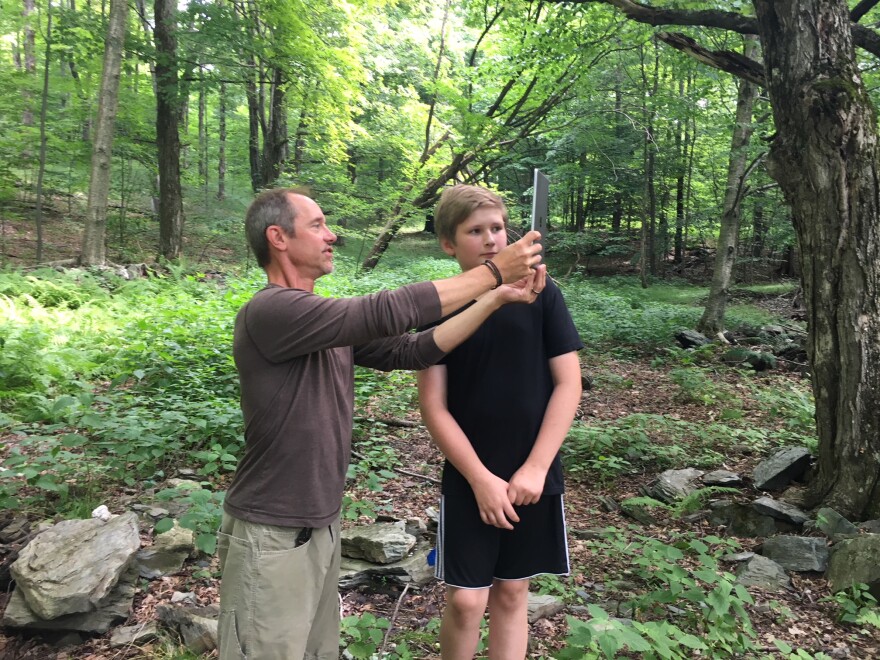There’s a good chance that one of Vermont’s most important historical sites has been hidden away high on a mountaintop in Bennington County. And teacher Steve Butz has been spending the past five years trying to uncover it and let the world know what’s hidden there.
On a recent sunny summer morning, Butz led a small group of high school students down a wooded path in Sandgate, near the New York border in southwestern Vermont.
He stopped near what looked like any other stone wall you might stumble across in any forest in New England. But this pile of rocks, Butz said, tells a story.
“So this is the fort,” he said, sweeping his arm across an expansive field of grass ringed with stones. “This is where their story began for me. … And this is where we really try to answer the question: ‘Was this site related to Daniel Shays, [and] if so how?’”

Daniel Shays was a farmer in Massachusetts who joined the local militia during the American Revolution.
After the war, Shays led a rebellion, which included thousands of other protesters who were angry when soldiers weren’t getting paid for their wartime service.
The rebels planned to raid the U.S. Armory in Springfield, Massachusetts, and in 1787 they were chased north by government forces, into the independent Republic of Vermont.
“Now there's historical references to there being a fort and a stockade and a blockhouse — so maybe this was the blockhouse, but we’re not sure,” Butz said. “We still have a lot of work to do to find out what was really going on here.”
Butz is a high school science teacher at Cambridge Central School in Cambridge, New York. And Butz thinks Shays and his followers retreated up here to Egg Mountain, in Sandgate, Vermont, where they might have lived for years at the end of the 18th century.
For the past few years Butz has brought his students out here for a summer course in archaeology, science, history and mapping.
"It's an extremely important site. It certainly is eligible now for the National Register of Historic Places. It could ultimately end up being a National Historic Landmark." — Vermont State Archaeologist Jess Robinson
Ajanta Deibel will be in 11th grade when school starts, and she’s standing in the middle of the fort. Deibel has an iPad and she’s spinning around in a tight circle, taking a series of photos that will be strung together to make a 3D image of the site.
“I thought it’d be really cool to actually be part of this, to be able to do the archaeology and learn about the story,” she said. “And then even maybe find some of the puzzle pieces that kind of build it more.”
Over the past few years, the students have uncovered dozens of artifacts. They’ve found coins and ceramic pieces and shards of metal.
In another part of the forest, a few students are scraping away at the dirt attached to the roots of an overturned tree.
This is the second summer that Alice Roosevelt has come out here to take part in the summer course.
“I think it’s just really interesting to find new things and just figure out what happened in our history and stuff like that,” said Roosevelt. “And I find it more interesting than the beach, honestly. And it’s also really fun because a lot of my friends are doing it as well.”

Butz worked with the former landowner since he started uncovering the mystery in 2013. Last year, The Conservation Fund — which is a national land preservation group — purchased the property as part of a 23,000-acre, three-state land deal.
The Conservation Fund is supporting Butz’s work, and the group signed an agrement with the state to turn over all the artifacts for preservation and study.
Vermont State Archaeologist Jess Robinson said that while the remote area will probably never become a major tourist destination, it might very well be one of the most important historical sites in Vermont.
“We really did not know that this archaeological settlement even existed on Egg Mountain,” Robinson said. “And it’s an extremely important site. It certainly is eligible now for the National Register of Historic Places. It could ultimately end up being a National Historic Landmark.”
Robinson said the work Butz and his students have done is impressive.
Butz tracked down some land records from Sandgate with Daniel Shays’ name on it, and while Robinson said that we can’t be 100 percent sure that Shays and his followers lived up on Egg Mountain at the end of the 18th century, the evidence is compelling.
And Butz, for his part, said he’s got a lot more work to do.
Correction 7:52 p.m. The Conservation Fund purchased the land on Egg Mountain as part of a three-state, 23,000-acre land deal. The wrong number of acres appeared in an earlier version of this story.





